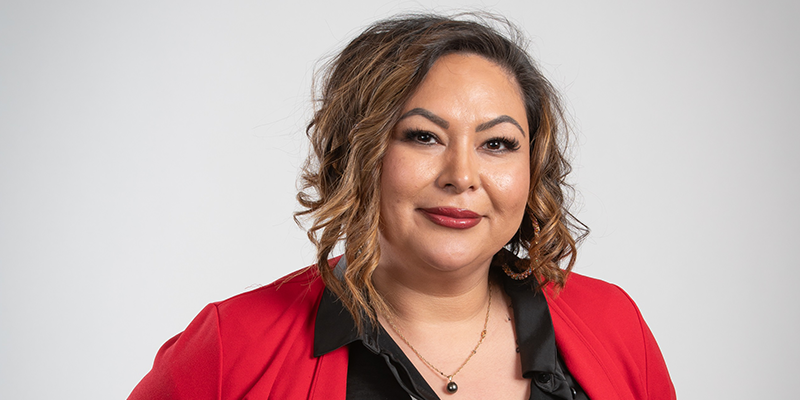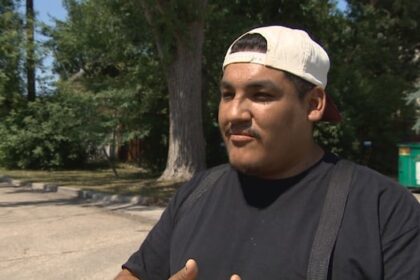As interim executive director Christina Biron takes the helm from Daniel St-Amour, who is retiring after 16 years of dedicated service, the Cree Board of Health and Social Services of James Bay (CBHSSJB) is focused on ensuring the organization’s continuity, guided by its strategic regional plan. Previously assistant executive director of Miyupimaatisiiun, which is responsible for most CHB services, Biron has worked alongside St-Amour since 2018. Biron started as a summer student at age 15 and has had a permanent job since 2006; her deep understanding of the board’s operations made her a natural choice to guide this transition. “It’s easier for me to slip in because of my longstanding involvement and working with the directors,” Biron told the Nation. “We’re taking two steps back to see the whole picture, ensuring our priorities are still at the forefront, because there are so many moving pieces.” Biron said the board is conducting an internal analysis with the executive team and new chairperson Jeannie Pelletier, elected last November, building on a commitment to culturally grounded local services. Inspired by a growing partnership with the Cree School Board, Pelletier suggested they may be hiring a Cree director responsible for communicating their innovative strategic direction. “It will be a key person for expanding creative ways of ensuring people know where we want to go and that they see themselves in it,” said Pelletier. “We want people to understand this will be the pathway to our health, incorporating our Eeyou ways of knowing, worldview and what kept our ancestors healthy.” Pelletier promotes accessible and family-centred primary care, which she introduced as director of Chisasibi’s Community Miyupimaatisiiun Centre (CMC) and is now being implemented in Waskaganish. Preparatory work is underway at all CMCs to expand this approach. “People were tired of repeating their story,” said Pelletier. “When they have a team taking care of their family’s needs, they’re less likely to go to emergency. We can catch things before, and they develop a trusting relationship with their provider.” Primary care assigns a social worker to patients, who are spared time in a waiting room, and ensures that these workers aren’t pulled away to emergency calls. “This model enhances client experience and the continuity of care, especially for those with chronic conditions,” affirmed Biron. “A walk-in clinic is often more transactional. We’re fostering a more holistic and interdisciplinary approach to care delivery.” Healthcare staff plan to use Waskaganish’s new CMC by the end of October. Edith Bobbish will also be the first chiskutimwaakin to provide midwifery services at a new birthing home in the community. Other new services include an Elders home that will open in Chisasibi by late winter. While Chisasibi’s new $300 million regional hospital is at least five years away, its current facility is undergoing renovations to ensure it’s up to code. In March, the community bought its own medevac plane fitted with stretchers and equipment to stabilize patients until they reach a southern hospital. “We are missing a lot of things,” Dr. Darlene Kitty recently told CTV News. “Certainly, an operating room and surgeons. We don’t have a CAT scan or an MRI.” The new hospital will greatly reduce the numbers sent south for care with expanded hemodialysis, medical imaging, chemotherapy treatments, obstetrical beds and palliative care. There are currently over 200 long-term patients staying at Montreal’s Espresso Hotel. Pelletier suggested a more visitor-friendly space may be needed. As the new hospital will require an estimated 700 staff members, the board is investing in workforce development with in-house training and certified programs in partnership with the Cree School Board, McGill University and John Abbott College. Enrolment is steadily growing in nursing and social work programs. Plans include a healing centre in Chisasibi for the CHB’s new addictions department and Nishiiyuu Miyupimaatisiiun, which offers land-based healing and traditional medicine initiatives. The isolated Mirage camp, which hosts land-based programs, is where St-Amour spent his last week as executive director in training sessions with the emergency team. A new mobile health unit designed with the Canadian Red Cross will bring emergency care directly to Cree communities. “The goal is to be autonomous in our response or at least provide a faster response to an emergency,” said St-Amour. A new group conferencing service called Peyakuutenuu Niishtam has been designed to help families known to Youth Protection navigate difficult situations. “When the youth is not doing well, it impacts the whole family, so it only makes sense to offer services that are more inclusive,” explained Pelletier. Above all, the priority is to demystify access to care. As Biron settles into her new role, she aims to create partnerships to better address the social determinants of health. “We know healthcare only accounts for 20% of overall health outcomes,” said Biron. “We need strategic partners to create healthier communities.” Pelletier has been promoting a more accessible and family-centred model of primary care, which she first introduced as director of Chisasibi’s Community Miyupimaatisiiun Centre (CMC) and has now been launched in Waskaganish. Preparatory work has been done across all CMCs to eventually expand this approach throughout the territory. “People were tired of repeating their story,” said Pelletier. “When they have a team taking care of their family’s needs, they’re less likely to go to emergency. We can catch things before and they develop a trusting relationship with their provider.” Under this approach, a social worker is assigned to patients, who don’t have to wait in a waiting room. The Board wants to safeguard primary care, ensuring the team looking after patients remains accessible to different families and isn’t pulled away to emergency calls. “This model enhances client experience and the continuity of care, especially for those with chronic conditions,” affirmed Biron. “A walk-in clinic is often more transactional. We’re fostering a more holistic and interdisciplinary approach to care delivery.” With healthcare staff planning to use Waskaganish’s new CMC by the end of October, a new birthing home is also coming to the community with Edith Bobbish recently announced as the first chiskutimwaakin to provide midwifery services. The CBHSSJB is also looking forward to completing a new Elders home in Chisasibi by late winter. While Chisasibi’s new $300 million regional hospital is at least five years away, it’s current facility has been undergoing renovations to ensure it’s up to code, with a seamless flow of essential services. In March, the community bought its own medevac plane fitted with stretchers and equipment to stabilize patients until they reach a southern hospital. “We are missing a lot of things,” Dr. Darlene Kitty recently told CTV News. “Certainly, an operating room and surgeons. We don’t have a CAT scan or an MRI.” With expanded hemodialysis, medical imaging, chemotherapy treatments, obstetrical beds and palliative care, the new hospital will greatly reduce the numbers sent south for care. There are currently over 200 long-term patients staying at Montreal’s Espresso Hotel. Pelletier suggested a more homey and visitor-friendly space may eventually be needed. Besides bringing more Cree patients back home, Pelletier wants at least half of board meetings and trainings to be held in Eeyou Istchee. During the last board meeting in Waskaganish, the team went for a hike and spent an afternoon fish scooping at the Smoky Hills site. As the new hospital is estimated to require 700 staff members, the CBHSSJB is investing in workforce development through tailored in-house training and certified programs in partnership with the Cree School Board, McGill University and John Abbot College. Enrolment has been steadily growing in nursing and social work programs. There are also early plans for building a healing centre in Chisasibi for the CBHSSJB’s new addictions department and its Nishiiyuu Miyupimaatisiiun department, which has been expanding land-based healing and traditional medicine initiatives. A wellness recovery program was recently held on Fort George Island. The isolated CBHSSJB-owned Mirage camp, which has also hosted land-based programs, is where St-Amour spent his last week as executive director in training sessions with the emergency team. A new mobile health unit has been designed in partnership with the Canadian Red Cross to bring emergency care directly to Cree communities. “The goal is to be autonomous in our response or at least provide a faster response to an emergency,” said St-Amour. Seeking to de-stigmatize mental health challenges, the CBHSSJB hopes to clarify client pathways to traditional healers, helplines and other resources. A new group conferencing service called Peyakuutenuu Niishtam has been designed to help families known to Youth Protection navigate difficult situations. “They can include Elders and people very close to the child to feel like a shared responsibility,” explained Pelletier. “Creating those safe spaces where people can feel okay to share their story or struggles. When the youth is not doing well, it impacts the whole family so it only makes sense to offer services that are much more inclusive.” Asserting that the CBHSSJB has grown so huge that most clients don’t realize the extent of available services, Pelletier suggested a current priority is to demystify access to care. As Biron settles into her new role, she aims to leverage partnerships at both the local and regional level to better address the social determinants of health. “Collective action at the community level allows for upstream work to reinforce protective factors for communities to thrive,” said Biron. “We know healthcare only accounts for 20 percent of the overall health outcomes. We need strategic partners to create healthier communities.”
Friday, 21 Nov 2025
Canada – The Illusion
Search
Have an existing account?
Sign In
© 2022 Foxiz News Network. Ruby Design Company. All Rights Reserved.
You May also Like
- More News:
- history
- Standing Bear Network
- John Gonzalez
- ᐊᔭᐦᑊ ayahp — It happened
- Creation
- Beneath the Water
- Olympic gold medal
- Jim Thorpe
- type O blood
- the bringer of life
- Raven
- Wás’agi
- NoiseCat
- 'Sugarcane'
- The rivers still sing
- ᑲᓂᐸᐏᐟ ᒪᐢᑿ
- ᐅᑳᐤ okâw — We remember
- ᐊᓂᓈᐯᐃᐧᐣ aninâpêwin — Truth
- This is what it means to be human.
- Nokoma












